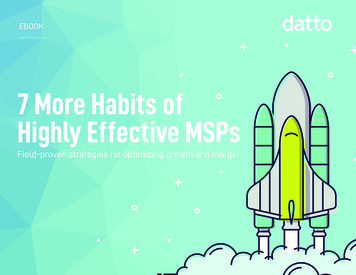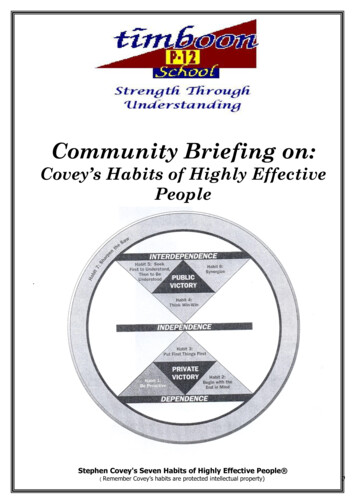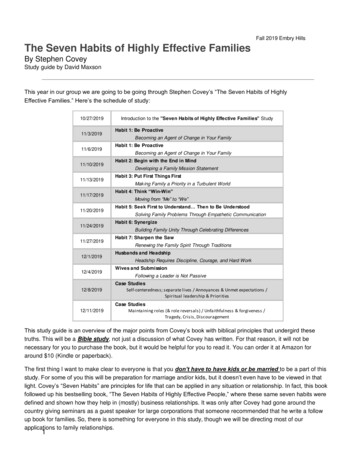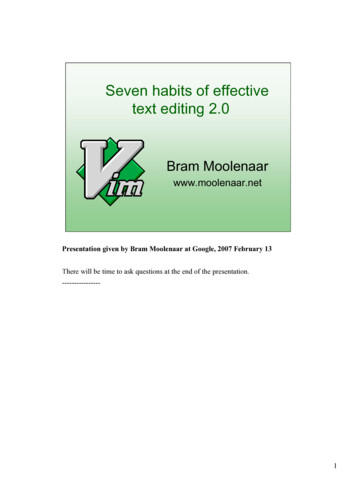
Transcription
EBOOK7 More Habits ofHighly Effective MSPsField-proven strategies for optimizing growth and margin
Our 7 Habits of Highly Effective MSPs ebook was so popular thatwe’ve decided to revisit the concept once more with 7 MOREessential habits for managed service providers (from MSPs).EBOOKSEVEN HABITSOF HIGHLYEFFECTIVE MSPSField-proven business strategies foroptimizing growth and marginThe 7 Habits of Highly Effective MSPsField-proven business strategies for optimizing growth and marginDOWNLOAD NOWAccording to CompTIA research, the number of companies that have adoptedmanaged services grew nearly 50% in 2015. In a recent survey of IT service providersconducted by RMM vendor Kaseya, 23% of respondents reported thattheir three-year average annual monthly recurring revenue (MRR) growth wasover 20%. An additional 30% reported average annual MMR growth between 11%to 20% for the past three years. Needless to say, the IT channel market ishealthy and growing.This ebook offers seven new strategic tips from successful MSPs that will helpyou optimize growth and profit. Use these to make the most of the current marketgrowth and outperform your competition!
Habit #1: BE THE “GO TO” GUYFor managed service providers, it is important to define exactly what your business does, theservices in which you specialize, and your edge over competitors in your space. It is essentialto be able to communicate your business value to potential customers. One effective way todifferentiate yourself from other IT providers is to develop a high level of expertise in a specificarea or areas. For example, an MSP that focuses on servicing SMBs in Healthcare and Finance oran MSP that specializes in a specific service or technology (i.e. backup and disaster recovery).Jay Strickland, President of NC-based MSP WingSwept, offers services based on client size ratherthan a specific vertical. “We look at vertical specialization as a potential liability,” he said. “Forexample, what if you catered specifically to real estate firms in 2008? You’d be out of work.”That being said, many MSPs have had success providing services to specific verticals. ThisOne effective way todifferentiate yourselffrom other IT serviceproviders is to develop ahigh level of expertisein a specific area or areas.decision should come down to your personal preference and the potential clients in your region.Mark Calzone, President of CT-based Ash Creek Enterprises said that while his company doesnot focus on a specific vertical, that approach “could be efficient from an operations standpoint,because you’re providing similar services for all or most of your clients.”According to Dale Shulmistra, co-founder of Invenio IT, a leading New York City-based managedservices provider, specialization is an essential part of the success of his business. “We spreadourselves too thin when we were first getting started with the company,” he said. “Then wefigured out that it’s better to for us specialize on specific services.” Over time, Shulmistranarrowed their service offerings down to disaster recovery, business continuity and IT security.While Invenio IT doesn’t intentionally service specific industries, many of their customers fallunder a certain profile. “When we first started out, I was hesitant to work with clients with HIPAAneeds,” Shulmistra said. “Over time, we wound up with a lot of HIPAA clients, because they have agreater need for the services in which we specialize.”3 datto.com
Over time, serving clients with similar needs will enable your to build up an expertise, which canbe applied across customers. Suddenly, you will be the “go to” guy for something. “It’s absolutelyeasier when you specialize,” said Shulmistra. “The first time we had to draft a HIPAA businessassociate agreement (BAA) was really difficult because we were learning the laws as we went.Now, it’s fairly straightforward. It definitely helps to have that previous experience.”Takeaway: To differentiate yourself from other IT providers, select and focus on specific areasof expertise and you’ll become a “go to” guy.Habit #2: BE CHOOSY ABOUT CLIENTSMany new IT service providers take whatever work they can get. This makes sense when you are“are just starting out, but as your business grows it is important to be more selective about yourcustomers. The first step: identify your ideal client. This will be dictated in part by your specificI find that the amount of worknecessary to support 100servers is not exponentiallyhigher than supporting10 servers. So, the profitareas of expertise, but there are additional factors to weigh.margin is much higher inlarger environments.in-house IT generally require less effort to support than customers that rely on Invenio IT for- Dale Shulmistra, co-founder of Invenio ITFor example, it is important to consider the level of effort it takes to support a customer’senvironment. “I prefer to work with larger customers—say 100 to 150 servers,” said Shulmistra.“I find that the amount of work necessary to support 100 servers is not exponentially higher thansupporting 10 servers. So, the profit margin is much higher in larger environments.” Another factoris the level of technical expertise the client has internally. Shulmistra said that customers withevery aspect of their technology needs.“We only go after clients that value technology and data,” said Shulmistra. It’s usually not worth theeffort to try to educate them if they don’t value technology. You’ll never convince them if they arejust looking for the cheapest price. Figure that out quickly and move on if they just don’t get it.”When it comes to current customers, don’t be afraid to cut ties. If a customer is not a goodfit it’s generally best to end your relationship with them. Shulmistra said that he’s had to end4 7 More Habits of Highly Effective MSPs
relationships with clients in the past, but it hasn’t happened in a while. He said that’s likelybecause they are selective about the customers they choose to work with.Takeaway: Identify your ideal customer. It’s important to figure out if a potential clientis a good fit with your business before you enter into an agreement with them.Over time, serving clientswith similar needs willenable your to build up anexpertise, which can beapplied across customers.Suddenly, you will be the“go to” guy for something.Habit #3: BUILD CUSTOMER TRUSTFor IT service providers, building customer trust is essential because you are accessing andprotecting their private technology and data in which their livelihood relies. “Trust starts with thevery first conversation,” said Shulmistra. “If you say you are going to call a potential client at 10AM, make sure you call them at 10 AM. Always follow through—otherwise, there’s no trust and norelationship.”Always offering customers impartial advice about technology will help you become a trustedadvisor to customers. Obviously, you need to generate revenue and make profits, but that doesn’tmean selling clients the most expensive products you can. It’s more important to recommendtechnology that helps them succeed regardless of its cost. Giving customers the right toolsalong with top-notch tech support, builds trust and ensures a long-lasting business relationship.Depending on the nature of your clients, you may want to take additional measures. For example,Shulmistra said that with healthcare customers, Invenio IT encrypts patient data but the clientholds the encryption key. “This gives clients control over their data and gives them confidence,but it protects our interests as well,” he said. “It’s actually impossible for us to decrypt their datawithout that key, so there’s no way we can be accused of inappropriately accessing it.”Takeaway: For IT service providers, trust is everything. Build a relationship based on trust bybeing reliable, honest and available.5 datto.com
Habit #4: STANDARDIZE TECHNOLOGY OFFERINGSStandardization allows you to develop expertise on technologies that you use—reducing the timeand effort necessary to deploy and manage them. This will mean different things to different ITproviders. For example, some might opt to use technology from a single vendor to deliver a service.According to Calzone, standardizing on specific vendors has been a successful route for his MSP. “Youwant to offer the same technologies to all of your clients—one security product, one DR, etc.,” he said.“This is beneficial in two ways. First, it’s easier to manage relationships with a finite set of vendors. Andsecond, your staff will develop expertise working with the specific products you choose.”Others might offer a few different options. However you approach it, you need to build in enoughflexibility that you can support a wide variety of clients. So, it’s important to choose technologiescan support lots of different of IT environments.Many successful IT service providers publish a service catalog to ensure that potential andcurrent customers understand the options available to them. It should be detailed enoughStandardization allowsyou to develop expertiseon technologies that youthat there is no ambiguity in what each service offers but not so technical that you lose themuse—reducing the time andeffort necessary to deployand manage them.only business continuity and security services. And, they’ve standardized on a small number ofaltogether. Since this document defines exactly what is provided in each offering, it is also anopportunity for you to explain exactly how your services differ from others in the market.Invenio IT takes a narrow approach to standardization. As noted above, the company offerstechnologies to provide these services. According to Shulmistra, this narrow focus is by design.“There are a number of benefits to standardizing on specific technologies,” he said. “Focusingon one thing allows you to be the best at it. Plus, you get efficiencies of scale as you grow yourbusiness and it’s easier to train new tech support staff.”Takeaway: Standardization of products allows you to develop an expertise on specifictechnologies you exclusively offer, which greatly reduces the time and effort necessary todeploy and manage them.6 7 More Habits of Highly Effective MSPs
Habit #5: PRICE FOR PROFITDeveloping a pricing strategy is all about making the margins you want and/or need on theservices you deliver. Start by evaluating your own business’ costs, such as the recurring costsfor the technologies you use to deliver services to your customers. Then, look at the rest of yourexpenses on a monthly basis. Your fees should be based on those numbers.“Understanding your own costs is essential,” said Jordi Tejero, President of Cape Coral, FL-basedCRS Technology Consultants. “Start with technology and staffing costs.” Added Shulmistra,“Understanding your costs is so important. We start with our costs, look at what we need to makefor a margin and then price in some profit.”Pricing structureIT service providers price and package theirservices in a variety of ways. Most choose somecombination of the following options:Many IT providers, especially those who are new to the business, make the mistake of pricingtheir services too low. Shulmistra said this is because try to beat their competitors on price.“Some cowboys out here think that loss leader pricing is acceptable,” he said, and suggested analternate approach. “Consider how you differentiate your services from what they offer and bePricing modelsPer user: Pricing is based on the numberof employeesPer device: The number of devices manageddictates pricingValue-based: Pricing is based on cost ofin-house IT staffSLA-based: Pricing is mapped to various tiersof service (e.g. gold, silver, bronze)ready to communicate why your service commands a premium price.”Make a plan for lost deals as well. “If we lose a deal based on price, we have follow up strategyto keep the conversation going,” Shulmistra said. “After six months, we reach out to find out ifthey are happy with the service they are getting from whoever won the bid. If they aren’t, they areusually willing to pay a little more for good service.”IT service providers use a variety of pricing models today, and yours will ultimately be dictated byyour business needs. Many IT providers price per user or per device, while others opt for a fixed-Service delivery optionsÀ la carte: The customer chooses the servicesthey need from a menu and pricing is calculatedaccordingly.Bundled: Services are grouped into packages andcustomer choose the bundle that best suits theirneeds.price model or a hybrid of the two.Takeaway: When it comes to pricing services, it is all about making the margins you want onthe services you deliver. Start by evaluating your own business’ costs, your fees should bebased on those numbers.7 datto.com
You Also Might Be Interested In:Habit #6: DEVELOP A SALES AND MARKETING PROCESSMany IT service providers struggle with sales and marketing. In some cases, that’s because they come from atechnical background rather than a business one. Others, particularly small shops, may simply not have the timeMSPeasy SeriesPRICINGMADE MSPeasyDiscover the Best Pricing Model for Your Needs(or think they have the time) to devote to sales and marketing. However, if you are looking to grow your business,developing a repeatable sales process is essential. A typical sales process might look something like this: Marketing/Prospecting: This is the process of generating leads. This may involve researching potentialclients, cold calling, attending industry events, outbound marketing (local ads, Google AdWordscampaigns, etc), and inbound marketing (blogging, social media, etc). Initial contact: The goal of initial contact is to to gather information about the company’s specific needsand qualify the lead’s potential to become a customer.Pricing Made MSPeasyFind the Best Model for Your Needs DOWNLOAD NOWTechnical presentation: This stage is a formal presentation or demonstration. It might feature a number oftechnologies depending on the customer’s specific needs. This step is reserved for well qualified leads. Close: This includes getting buy-in from decision makers, negotiating price, etc.According to Shulmistra, sales and marketing are a major focus at Invenio IT. “You are providing a service.MSPeasy SeriesFor us, that’s technology,” he said. “But, the business side is a bigger focus for me. But, I come from a businessMARKETINGMADE MSPeasybackground, I have finance degree and I’ve worked for Fortune 500 companies.”The MSP’s Ultimate Guide to MarketingThis, of course, isn’t the case for most IT providers. So, Shulmistra suggested starting with your strengths.“For example, I’m a lot better in person than over the phone,” he said. “So, I tend to try to do a lot of prospectingat industry events. Someone else might be a really strong writer and use that to generate leads.”Marketing Made MSPeasyTakeaway: For MSPs looking to grow their business, taking the time to develop a repeatable andtraceable sales and marketing process is essential to growth.Effective Tips for MSPs from MSPsDOWNLOAD NOW8 7 More Habits of Highly Effective MSPs
Habit #7: GO TO SCHOOLPeer groups, such as HTG,are a popular option for ITservice providers lookingto further their education.It goes without saying, but you won’t stay ahead of your competition by resting on your laurels. One pieceThese groups meet locally oronline and allow membersto learn from each other, informal and informal settings.settings. Peer groups offer sessions lead by industry veterans on topics such as management, sales andof that is understanding your business and the constantly changing market you play in. That’s why ongoingeducation is essential.Peer groups, such as HTG, are a popular option for IT service providers looking to further their education.These groups meet locally or online and allow members to learn from each other, in formal and informalmarketing, employee relations, vendor engagement and new technologies. Members are encouraged tonetwork and bounce ideas off each other as well.Another option is to seek certification on specific technologies you use to deliver services. Many tech vendorsoffer product-specific education and certification programs. And, there are a number of organizations thatoffer more general IT training opportunities. For example, CompTIA offers four IT certification series that testdifferent knowledge standards—from entry-level to expert.You Also Might Be Interested In:Shulmistra has a less formal, but still structured, method for staying in the know. “At the moment, I’m notinvolved in any groups or training,” he said. “But, I start every day reading tech, marketing, and businessMSPeasy SeriesRANSOMWAREMADE MSPeasyThe MSP’s Guide to Saving the DayHoarticles to keep up on everything. And, I pass important articles on to my staff to keep them informed as well.”Takeaway: To remain competitive in an industry of constant change, ongoing education and certificationis essential.telopenRansomware Made MSPeasyThe MSP’s Guide to Saving the DayDOWNLOAD NOW9 datto.com
CONCLUSIONSuccessful managed service providers “work smart” as the expression goes. It’s all about beingselective—with the clients you take on, the vendors you partner with, how you present yourselfto the public, and the services you decide to deliver. Highly effective MSPs play to their strengthsand build on them, but they aren’t afraid to evolve and adapt either. They also refuse to sellthemselves short. If you are delivering superior service, your clients will pay a premium price.“The price you charge definitely affects the perception of your worth,” said Shulmistra. “But if youcharge a higher price, you need to have the skills to back it up.”FINAL TAKEAWAYSYou Also Might Be Interested In: To differentiate yourself from other IT providers, select and focus on specific areas of expertise andyou’ll become a “go to” guy. Identify your ideal customer. It’s important to figure out if a potential client is a good fit with yourbusiness before you enter into an agreement with them. For IT service providers, trust is everything. Build a relationship based on trust by being reliable,honest and available. Standardization of products allows you to develop an expertise on specific technologies youexclusively offer, which greatly reduces the time and effort necessary to deploy and manage them. When it comes to pricing services, it is all about making the margins you want on the services youdeliver. Start by evaluating your own business’ costs, your fees should be based on those numbers. For MSPs looking to grow their business, taking the time to develop a repeatable and traceable salesand marketing process is essential to growth. To remain competitive in an industry of constant change, ongoing education and certification is essential.MSPeasy SeriesBUSINESSMADE MSPeasySuccess KitBusiness Made MSPeasySuccess KitDOWNLOAD NOW10 7 More Habits of Highly Effective MSPs
Our 7 Habits of Highly Effective MSPs ebook was so popular that we’ve decided to revisit the concept once more with 7 MORE essential habits for managed service providers (from MSPs). According to CompTIA research, the number of companies that have adopted managed services grew nearl










